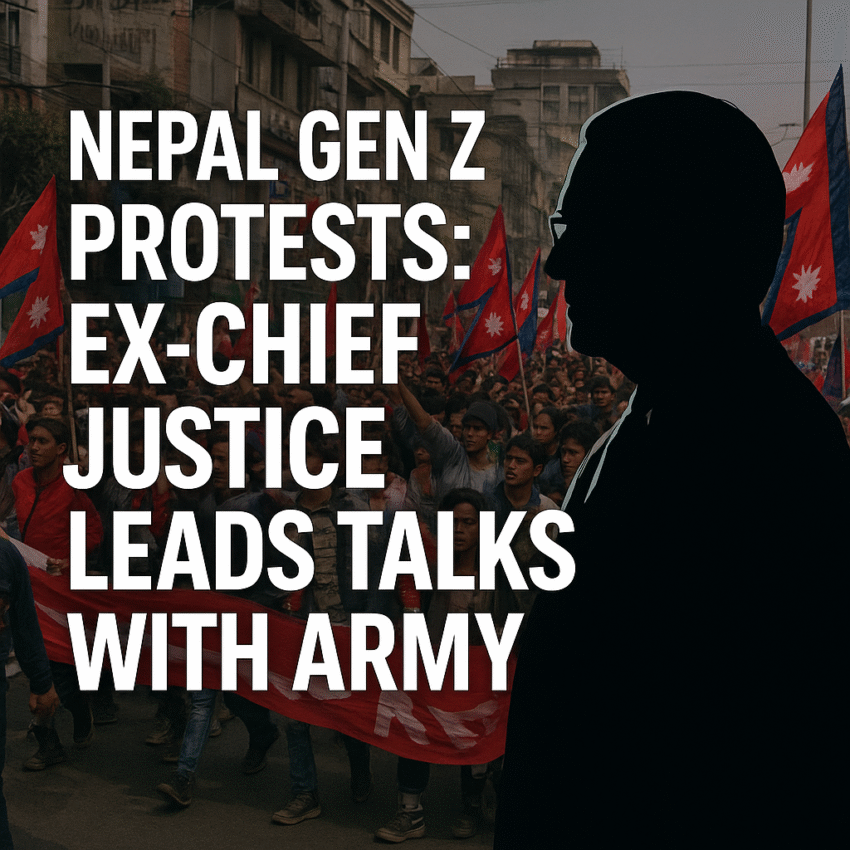Nepal Gen Z Protests: Rising Tide
Nepal is witnessing a historic moment as the country’s Gen Z protests intensify across major cities. What began as small demonstrations on social media has now turned into a nationwide movement demanding structural reforms, transparency, and greater political accountability.
Amid growing pressure, Nepal’s protestors have taken a bold step by appointing former Chief Justice of Nepal as their chief negotiator to lead talks with the army. This unusual yet powerful move reflects both the determination and the maturity of the youth-led uprising.
Why Nepal Gen Z Protests Are Different
The Nepal Gen Z protests are unique compared to previous political movements in the country. Unlike earlier demonstrations driven by party politics or ideological divisions, today’s youth are largely united by their demand for systemic change, good governance, and accountability.
Key Features of the Protests:
- Leaderless yet Organized: Social media platforms like TikTok, Instagram, and X (formerly Twitter) are being used to coordinate marches, sit-ins, and digital campaigns.
- Youth-Centric Demands: Protestors are calling for improved education, employment opportunities, environmental reforms, and military accountability.
- Non-Violent Approach: So far, the protests have emphasized peaceful resistance, a deliberate choice to contrast earlier cycles of violence in Nepalese politics.
Appointment of Former Chief Justice
In a surprising turn, the protestors selected Nepal’s former Chief Justice to lead negotiations with the army. This decision is rooted in the perception that the judiciary, despite its own flaws, represents impartiality and fairness compared to the mistrusted political class.
The former Chief Justice’s appointment sends two strong signals:
- Neutrality in Negotiations: Protestors want a credible figure who is not affiliated with political parties.
- Trust in Institutions: While political leaders are seen as corrupt, the judiciary retains symbolic respect.
This move highlights the growing political sophistication of Gen Z, showing their ability to merge symbolism with practicality.
Army’s Role in the Crisis
The Nepal Army has long played an outsized role in the nation’s politics, from the Maoist insurgency years to its involvement in maintaining internal order. With PM Oli’s resignation, the army is once again seen as a crucial player in stabilizing the political situation.
However, the presence of the army also raises fears. Many protestors worry that if talks collapse, the military could attempt to suppress the uprising. By nominating the former Chief Justice to mediate, the youth movement seeks to prevent escalation and foster dialogue.
Voices from the Streets
For many protestors, the Nepal Gen Z protests are not just about politics but about reclaiming their future.
“We don’t want a token leader or empty promises. We want real reforms,” said Anisha Koirala, a 22-year-old university student marching in Kathmandu.
“This is not about social media likes. This is about changing how Nepal is governed,” added another protestor.
The emphasis on real change and structural accountability sets this movement apart from earlier youth-led campaigns that often fizzled out after government assurances.
Regional and International Reactions
Nepal’s unfolding crisis has caught the attention of regional and international observers. India, China, and the U.S. are closely monitoring developments, given Nepal’s strategic location.
- India: Advocates for stability, with concerns about refugee spillovers.
- China: Watching carefully, wary of any movement that weakens its influence in Nepal.
- U.S. & EU: Have quietly expressed support for peaceful, youth-driven democratic reforms.
The Nepal Gen Z protests are also inspiring youth activists across South Asia, who see the movement as proof of generational power to challenge entrenched elites.
What Lies Ahead
The success of the Nepal Gen Z protests depends on two critical factors:
- Negotiation Outcomes: Whether talks between the army and the former Chief Justice deliver concrete reforms.
- Unity of the Youth Movement: Sustaining energy, avoiding internal divisions, and keeping protests non-violent will be crucial.
If successful, Nepal could witness the dawn of a new era of youth-led governance. If not, the risk of political instability or even military intervention looms large.
Conclusion
The Nepal Gen Z protests represent more than just youthful energy — they symbolize a generational demand for a new social contract. By choosing a respected former Chief Justice to lead talks, protestors have demonstrated political maturity and strategic foresight.
Nepal now stands at a crossroads. The world is watching to see whether this youth-led movement can bring lasting change or if old political patterns will reassert themselves. What is clear, however, is that Gen Z has announced its arrival as a decisive force in Nepal’s political future.

